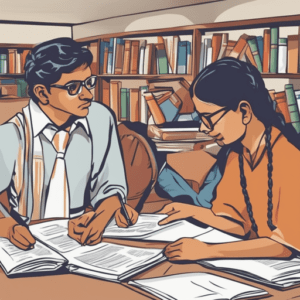All India Survey on Higher Education 2020-21: Analysis & Implications for Achieving a 50 percent GER by 2035
Background
The All India Survey on Higher Education for the fiscal year 2020-21, orchestrated by the Ministry of Education, Government of India, offers profound revelations into the intricacies of the nation’s higher education landscape.
This discourse aspires to dissect the statistics concerning institutions, enrollment, academic staff, and additional metrics and deliberate upon their implications concerning India’s ambitious target of attaining a Gross Enrollment Ratio (GER) of 50 percent by the year 2035, as enunciated in the National Education Policy (NEP) 2020. Detailed information has been derived from the Press Information Bureau, Delhi release (Release ID: 189451, 29 January 2023).
Institutional Landscape
Per the AISHE report of 2020-21, India boasts 1,113 accredited Universities and University-like institutions, alongside 43,796 colleges and 11,296 autonomous educational entities. Nonetheless, it remains uncertain whether all establishments engaged in advanced learning within the nation have found representation in the AISHE 2020-21 records. Nevertheless, a commendable annual increase in the number of such entities covered by the AISHE is a laudable progression within higher education institutions nationwide.
This extensive array of educational establishments is the cornerstone of India’s tertiary education framework. Nevertheless, to secure a GER of 50 percent, it is of paramount significance to ascertain that these institutions impart superior education and are accessible to all segments of society.
Enrollment Metrics
The survey illuminates a substantial upsurge in enrollment within higher education, with the cumulative tally surpassing a noteworthy 4.14 crore (41.4 million) students during 2020-21. This represents the initial instance when enrollment has exceeded the four crore (40 million) milestone in the Indian context. The augmentation rate of 7.5 percent from 2019-20 and an impressive 21 percent escalation from 2014-15 underscore a positive trajectory in broadening access to advanced learning.
Of particular significance is the enrollment of female scholars, which has eclipsed the two crore (20 million) threshold, signifying a growth of 13 lakh from the preceding year; this overtly manifests the strides in fostering gender parity within higher education. Additionally, there is a commendable upswing of 28 percent in the enrollment of Scheduled Caste (SC) students and an even more noteworthy 38 percent upsurge in female SC student enrollment when juxtaposed with data from 2014-15. Similarly, there has been a substantial increment of 47 percent in Scheduled Tribe (ST) student enrollment, coupled with a striking 63 percent amplification in female ST student enrollment.
These statistics testify to various governmental initiatives’ efficacy toward inclusivity and social justice in higher education. Nonetheless, sustained endeavors are indispensable to bridge these disparities further and guarantee equal opportunities for underrepresented communities.
Infrastructure Endeavors
The data derived from the survey also furnishes insights into the accessibility of infrastructure within the purview of higher educational institutions. The numerical representation suggests a favorable evolution, with 97 percent of institutions boasting libraries, 88 percent equipped with laboratories, and 91 percent featuring computer centers. The proliferation of skill development centers is also evident, with 61 percent of institutions offering such facilities. Enhanced connectivity to the National Knowledge Network is palpable, with 56 percent of institutions currently connected, compared to 34 percent in 2019-20. These affirmative statistics testify to amplified access to pivotal resources and technology-driven learning milieus for scholars.
Faculty Dynamics
The AISHE report for 2020-21 documents an augmentation of 47,914 academic staff members compared to the antecedent year. This upswing is ostensibly attributed to an augmented scope of institutions during the given period. Nevertheless, the caliber of the academic staff remains an imperative concern that necessitates immediate attention to foster a high echelon of erudition. Emphasizing faculty development initiatives, incentivizing research and ingenuity, and enticing seasoned professionals into the academic sphere are pivotal measures to elevate the quality of education.
Implications and Culmination
The data collated through the AISHE survey for 2020-21 underscores the headway achieved in broadening access to advanced learning in India, particularly over the preceding year. Nonetheless, additional exertions are mandated to realize the aspirations outlined in the NEP 2020, particularly attaining a 50 percent GER by 2035. The areas demanding focus encompass enhancing educational quality, elevation of faculty standards, cultivation of research and innovation, and the assurance of comprehensive inclusivity for all societal segments. Furthermore, investments in infrastructure enhancement, digital literacy, and the stimulation of collaborative alliances between academia and industry can further expedite the progress of advanced learning in India.
In summation, one may deduce that the surge in enrollment and the augmented availability of infrastructure, in conjunction with an unwavering commitment to quality enhancement, will undoubtedly contribute substantially to India’s odyssey toward realizing a 50 percent GER by 2035. By fostering equitable access to advanced learning, India can empower its populace, enhance workforce competencies, and catalyze economic advancement, thereby nurturing a brighter destiny for the nation.
By emphasizing quality, inclusiveness, and infrastructural augmentation, India stands poised to forge a robust tertiary education system that empowers its citizenry and propels comprehensive socio-economic progress.
Contemporary Challenges in Indian Higher Education: A Concise Appraisal based on AISHE 2020-21 Data
The Impact of Globalization on the Quality of Indian Higher Education
The Challenges of Globalization for Indian Higher Education (2023)
Role of Government in the Globalization of Indian Higher Education (2023)
Opportunities of Globalization for Indian Higher Education (2023)
The Globalization of Indian Higher Education: Trends and Implications
Challenges and Opportunities of Foreign Faculty Recruitment in Indian Universities
Global Rankings & Indian Higher Education: Analyzing the Influence of Globalization




